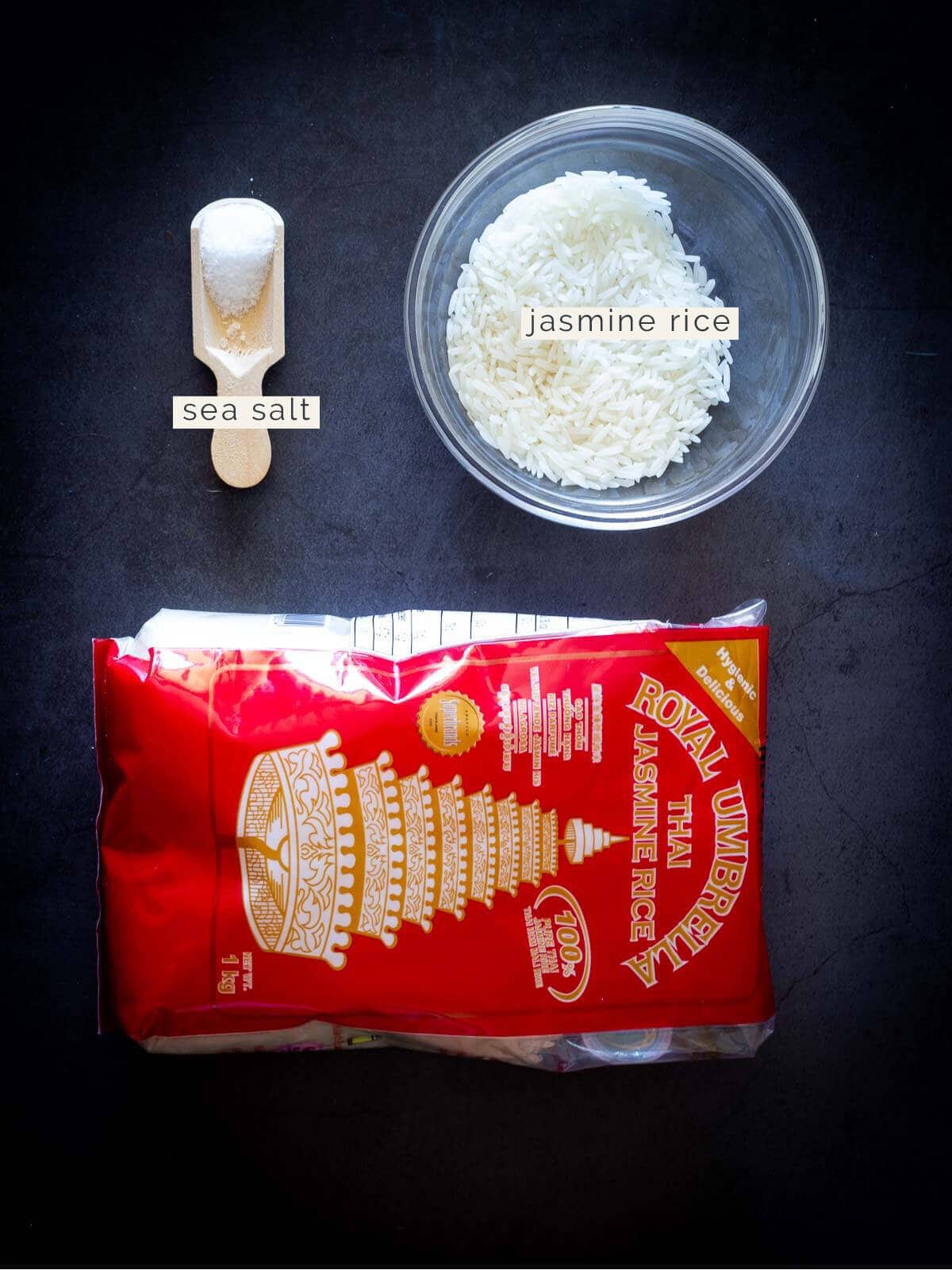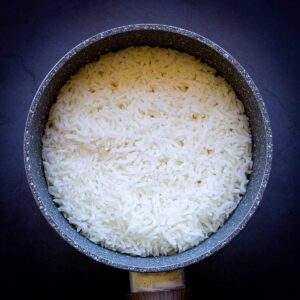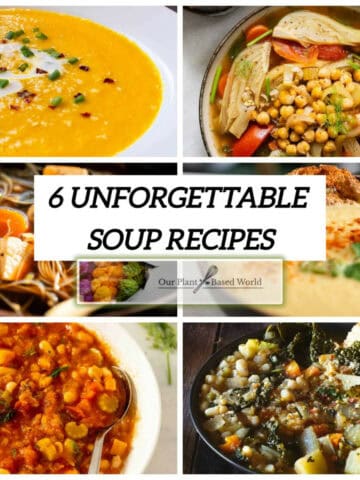Hey there, rice enthusiasts! Have you ever found yourself in a sticky situation—literally—with your jasmine rice? We've all been there. But fear not, because today, we're diving into the ultimate guide on how to cook long-grain jasmine rice, both on the stovetop and in the Instant Pot. Trust us, it's a game-changer.

Jasmine Rice makes aromatic rice pudding the best side for your Thai Curries. You have to remember not to move it and use the right amount of water—no big secrets.
When having a Thai Curry, pairing it with Jasmin rice is essential. I doubt any Thai restaurant would dare to serve a curry without its perfect match. We also love eating this plain rice with spicy garlic edamame.
You may even ask for an extra portion.
A Thai Curry should have a lot of delicious juice, usually spicy. Of course, you can tune it to your liking, but this is where Jasmin rice comes into play.
Mix and match your curry content with the delicate flavor of this aromatic rice.
Jump to:
🧾 Ingredients
- Jasmine rice
- Water
- Sea salt (optional)

🔪 Instructions
Cooking rice is easy, but cooking perfect jasmine rice on the stovetop or on rice cookers is different. We will answer the following questions in this blog post to ensure you always get the best fluffy rice and avoid mushy rice at all costs!
- How to cook jasmine rice on stove?
- How to cook jasmine rice in rice cooker?
You have come to the right place. Find all the details in the recipe below!
How to cook Jasmine rice on the stove
For perfectly cooked Jasmine rice on the stove:
- Rinse the white rice only once (to naturally release and eliminate the excess starch) and throw the water away.
- Pour the Thai Jasmine rice into a small or medium saucepan.
- White Jasmine rice water ratio. Add four cups of water into the saucepan (Rice ratio: 1.25 cups of water for one cup of rice). Add one teaspoon salt if you want your jasmine rice slightly salted. This is unnecessary as your curry will have plenty of flavors.
- Cook Jasmine rice. Bring it to a boil on medium-high heat. Reduce heat to medium-low as soon as it boils. Cover with the lid, leaving it open slightly, and let the rice simmer. Do not lift the lid nor stir the Rice during the cooking time.
- Serve. When the water is completely evaporated, your freshly cooked rice is ready. Fluff with a fork, and serve hot. I personally like to leave the rice sitting for a couple of minutes before serving.
How to cook Jasmine rice in a rice cooker
Making Jasmine rice using this cooking method is optimal because it needs no babysitting, and even if the rice is ready, the rice cooker will go off, and your rice won't be burnt or overcooked.
I love rice cookers, but I use them for many recipes. Jasmine rice is super easy to make on the stovetop, but why even bother if you have a rice cooker?
- Rinse Jasmine rice only once and throw the water away. Rinsing rice is key to reducing the excess starch.
- Cook it by putting the rinsed rice into the rice basin.
- Water to rice ratio: Add 3.6 cups of water into the basin and a cup of rice (1.2 cups for every cup of rice, using measuring cups). Add salt (1 teaspoon) if you want your Rice slightly salted.
- Cover with the tight-fitting lid (usually a glass lid), place the rice basin into the rice cooker, and switch it on. Do not lift the lid nor stir the Rice throughout the cooking process.
- Ready. When the water is fully evaporated, the rice cooker will display the warm light, and your perfectly cooked rice will be ready to eat. Fluff and separate grains with a fork and serve with the rice cooker's rice paddle to avoid scratching it. I personally like to leave the rice to rest for a couple of minutes before serving.
Troubleshooting
Excess water. If you feel like you tried the rice grains that are already cooked but still have water, drain using a fine mesh strainer and serve.
The Jasmine rice is still hard. Add water and let it simmer. I only a few tablespoons of water in half-cup increments to avoid having excess water and making the rice mushy.
🥡 Storing and leftovers
You can store leftover rice using an airtight container for other healthy recipes.
Basmati rice and Jasmine rice are great for rice pudding due to their fantastic aroma. We like using it for our cardamom rice pudding.
Fried rice
Fluffy Jasmine rice makes great fried rice. To make Chinese-style fried rice, I like heating a tablespoon of peanut oil or sesame oil, adding the cooked rice, and stirring for a couple of minutes with some soy sauce, a tablespoon of white vinegar, and additional veggies like green beans or sliced carrots.
🍚 Choosing the right rice
What does jasmine rice taste like?
Jasmine rice has a nutty, floral flavor and a slightly sticky texture. It is light and fluffy and has a subtle sweetness. It tastes like slightly sweet, aromatic rice has a light and fluffy texture, and is often used in Asian cuisine.
Jasmine rice is grown in Thailand and is named after the jasmine flower because, when cooked, Jasmine rice releases a soft, floral fragrance.
Why Jasmine rice and not regular long-grain rice?
Jasmine rice is a long grain that becomes sticky when cooked. It is not as sticky as Sushi Rice but three times stickier than regular American long rice.
Also, when you cook Jasmine rice, it becomes very aromatic, which makes a big difference when consuming Thai delicacies. The cooked jasmine rice grain is moist, soft, and slightly sweet.
Calories in jasmine rice cooked: 181 kcal, for 1 cup serving.
Regular long grain rice: 160 kcal, for 1 cup serving.
According to Healthline nutritional comparison.

Brown Jasmine rice
You can undoubtedly use Brown Jasmine Rice. It is more nutritious, has more fiber, and has more complex carbohydrates (slowly digested) than its regular counterpart.
You may need to plan to add a cup of water and ten extra cooking minutes to get it perfectly cooked. Just remember not to move it.
Try to pick a cooked grain from the surface. If it is still hard and has dried out, add a cup of water at a time until the cooked rice is soft enough. You want evenly cooked grains.
How to Season Jasmine Rice Like a Pro
Ah, jasmine rice—fluffy, aromatic, and the perfect canvas for flavors. But let's be real, sometimes it can be a bit, well, plain. So, how do you take it from "meh" to "wow"? Seasoning, my friends! Here's how to elevate your jasmine rice game.
- Salt: The most straightforward way to season jasmine rice is by adding salt. A teaspoon per cup of rice is a good starting point. Adjust to taste.
- Oil or Vegan Butter: A tablespoon of olive oil or vegan butter adds richness and helps separate the grains for that fluffy texture we all love.
- Garlic and Onion: Minced garlic and onion can be sautéed in the pot before you add the rice and water. They add a subtle flavor that pairs well with almost any dish.
- Herbs: Fresh herbs like cilantro or basil can be stirred in after the rice is cooked. Dried herbs like oregano or thyme can be added before cooking.
- I have found it helpful to use the regular long-grain rice, using the same method on this recipe and adding either one Jasmin Tea Bag or Two Ginger Slices to the cooking water.
- Turmeric or Saffron: For a pop of color and a hint of earthiness, add a pinch of turmeric or saffron to the water before cooking.
- Chili Flakes: If you're into heat, a sprinkle of red chili flakes can do wonders. Add it to the pot along with the rice and water.
- Citrus Zest: A bit of lemon or lime zest stirred in after cooking adds a fresh, zesty note. Perfect for summer dishes!
Pro seasoning tips
- Balance is Key: Don't go overboard with the seasonings. Jasmine rice has a delicate flavor that you don't want to overpower.
- Taste Test: Always taste the rice before serving and adjust the seasoning if needed.
If you are looking for an alternative to even healthier and yummy rice, check out our post on How to Make a Cauliflower Rice.
This Jasmin rice is also the perfect companion for a Maple Glazed Baked Tofu and Glazed Carrots as part of a Christmas vegan recipes.
🍛 How to pair Jasmine rice

- Stir-Fry Veggies: A classic! Think bell peppers, zucchini, and vegan chicken strips sautéed in a tangy sauce. You can also make it one of the star components of a Hawaiian tofu and rice bowl.
- Curry Away: A rich, plant-based curry with coconut milk and tofu is a match made in heaven. Check our red, yellow, green, chickpea-coconut, and Massaman curry recipes.
- Grilled Goodness: Grilled portobello mushrooms or eggplant slices add a smoky flavor that complements the rice.
- Asian Fusion: Think vegan sushi rolls or a hearty miso soup.
- Salad Sides: A fresh mango or spicy cucumber salad can add a refreshing contrast.
Although sweet sticky rice is more commonly used in Chinese cooking, Jasmine rice is an excellent choice to pair Chinese Tofu recipes.
❓ FAQ
No, Jasmine rice does not contain gluten. Like all rice varieties, Jasmine rice is naturally gluten-free, making it a great choice for those with celiac disease, gluten intolerance, or anyone following a gluten-free diet. However, if you are highly sensitive, be cautious of potential cross-contamination with gluten-containing foods, especially when dining out or buying pre-packaged or flavored rice products. Always check labels or inquire about preparation methods to ensure safety.
⭐ If you try this rice recipe, let us know! 💬 Leave a comment, rate it, and don't forget to tag us @ourplantbasedworld on Instagram. Cheers!
📋 Recipe

How to Cook Long Grain Jasmine Rice (Stovetop & Instant Pot Methods)
Equipment
Ingredients
- 3 cups jasmin rice organic
- 3.6 cups water
- ½ teaspoon salt
Directions
Instant Pot Method:
- Rinse the Rice only once (to get rid of the excess starch) and throw the water away.
- Put the rice into the rice basin.
- Add 3.6 cups of water into the basin (1.2 cups of water for every cup of Rice). Add 1 teaspoon of salt if you want your Rice slightly salted. This is not needed as you will have plenty of flavor with your curry.
- Cover with the lid and place the rice basin into the rice cooker and switch it on. Do not lift the lid nor stir the rice during the cooking time.
- When the water is fully evaporated, the rice with be cooked. Fluff with a fork and serve hot.
Stovetop Method:
- Rinse the Rice only once (to get rid of the excess starch) and throw the water away.
- Put the rice into the saucepan.
- Add 4 cups of water into the saucepan (1.25 cups of water for every cup of Rice). Add 1 teaspoon of salt if you want your Rice slightly salted. This is not needed as you will have plenty of flavor with your curry.
- Bring to boil. Lower the heat to medium-low as soon as it boils. Cover with the lid, leaving it opened slightly and letting it simmer. Do not lift the lid nor stir the Rice during the cooking time.
- When the water is fully evaporated, the Rice with be cooked. Fluff with a fork and serve hot.
Video
Notes
Nutrition Facts
🌡️ Food safety
- Cook to a minimum temperature of 165 °F (74 °C)
- Do not use the same utensils on cooked food that previously touched raw meat
- Wash hands after touching raw meat
- Don't leave food sitting out at room temperature for extended periods
- Never leave cooking food unattended
- Use oils with high smoking points to avoid harmful compounds
- Always have good ventilation when using a gas stove
See more guidelines at USDA.gov.
The information shown is an estimate provided by an online nutrition calculator. It should not be considered a substitute for a professional nutritionist's advice. See our full Nutritional Disclosure here.
Please note that some of the links here are affiliate links, and I will earn a commission if you purchase through those links. I recommend all of the products listed because they are companies I have found helpful and trustworthy.
As the lead content writer and recipe developer at Our Plant-Based World, he combines his passion for health and sustainability with a Plant-Based Nutrition Certification to create accessible, delicious vegan recipes. His expertise in plant-based cooking supports the blog's mission of fostering a healthier, environmentally conscious lifestyle through simple and seasonal dishes. His commitment to making vegan cooking enjoyable and inclusive for everyone shines in each recipe and article.













Marinela
Now I know how to make my jasmine rice side dish perfect all the time. Thanks for the useful tips!
Gus
Hi Marinela, we are glad to found the tips helpful!
Kayla DiMaggio
I have always struggled with making rice but this was the first time I was able to make it perfectly, thank you!
Gus
That is really nice to hear Kayla! makes us happy!
Natalie
Beautifully cooked. Looks delicious.
Gus
Thank you for your review Natalie! I am so glad to hear that the food looks delicious and it was a pleasure to cook for you.
Shilpa
Looks perfect. I don’t use jasmine rice but I guess I’ll be making it soon.
Taly
Me encanta el arroz Jazmín!
Suelo acompañarlo con guarnición favorita: los Falafels! A mi gusto, otra buena combinación...